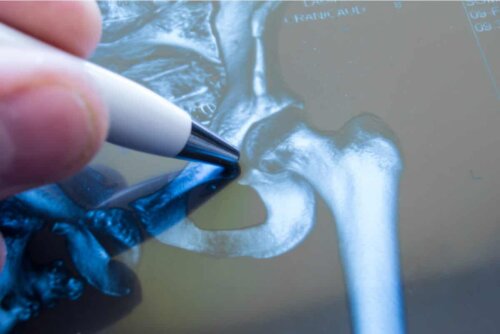Causes, Symptoms and Treatments for a Hip Labral Tear


Written and verified by the doctor Leonardo Biolatto
A hip labral tear is a fairly common condition in athletes such as ballet dancers, soccer players, and ice hockey players.
The labrum is a cartilaginous ring between the femur and the hip. It lines the outer edge of the joint socket in question. Thus, it helps keep the longest bone in the body in the fitting position.
This injury is as common as it’s serious and often requires surgery. Today’s article contains what you might want to know about a hip labral tear and how to prevent it.
What is a hip labral tear?
The hip joint is a ball and socket. Furthermore, the acetabulum is the cavity in the coxal bone into which the upper part of the femur fits.
This part, shaped like a round ball, is the femoral head. There’s a ring of cartilaginous tissue at the edge of the socket, the labrum. As an article in Sports Medicine Oregon points out, this structure increases the stability of the joint.
A hip labral tear is damage to the cartilage tissue and it ceases to perform its function as it should. The femoral head loses part of its support as a consequence.
There are many causes, both acute and chronic. For example, it may be as a result of femoroacetabular impingement or osteoarthritis. As noted above, it’s quite common in athletes.

Related symptoms
Hip labral tears are sometimes asymptomatic. However, Mayo Clinic specialists point out that symptoms are more common. For example, there may be a pain in the hip that extends toward the groin.
That pain worsens when walking or continued sitting or standing. Some people experience stiffness in the hip joint as they have a poor range of motion.
The joint may also creak with certain leg movements or appear locked. The problem is it can lead to complications if not treated. In fact, it increases the likelihood of osteoarthritis over time.
Causes of a hip labral tear
As we pointed out throughout the article, hip labral tears are more common in athletes. However, there are many other causes.
It’s common in physical activities based on repetitive movements with the hip joint. This is because these types of movements can progressively wear down the joint.
Sports such as golf, ice hockey, and other contact sports like football frequently lead to labral tears so they’re risk factors.
According to an article by the Hospital for Special Surgery, this condition may be due to structural abnormalities. Some associated diseases are osteoarthritis and femoroacetabular impingement.
The latter consists of abnormal contact between the femoral head and the hip socket. Hence, it can be due to either a malformation of the femur or a malformation of the acetabulum. The thing is this kind of body contact wears down the labrum more quickly.
Diagnosis
Diagnosing a hip labral tear can be complex. This is why it’s essential for a physician to do a proper examination of the joint. They’ll likely have to move the leg in various positions to do so.
Certain complementary tests like x-rays are usually necessary to rule out other injuries though. This is because the image makes it possible to find a fracture or other anomaly. It’s particularly useful if the person experienced a blow.
However, the x-ray doesn’t reveal soft tissues so a doctor must resort to magnetic resonance imaging at times.
Treatments for labral tears
A labral tear is hard to treat end even though the medical or physiotherapeutic approach is useful in slight tears, it might require surgery.
Certain measures are usually recommended in all cases, regardless of whether a person undergoes surgery or not. One of them is to lose weight — if necessary. The goal is to reduce hip joint overload.
In the case of athletes, their physical activity habits need to be modified. The attending physician will probably advise them to reduce the intensity or try alternate forms of training.
Check out these Three Exercises to Strengthen Your Hip Flexors
Non-surgical approaches
Medical treatment seeks to relieve pain and reduce inflammation in this injury. This is why doctors usually prescribe non-steroidal anti-inflammatory drugs. Ibuprofen or naproxen are commonly prescribed, although some cases might require corticosteroid infiltrations.
Physiotherapy is one of the pillars of treatment but must be done by a specialist. The idea here is to help a person recover the range of motion of the joint through specific exercises.
It also seeks to increase strength and stretching, so that the hip is more stable during physical activity.

Surgical treatment
Surgery is usually one of the best options for treating severe tears. It’s particularly useful when non-surgical treatments have failed i.e. when a person can’t recover their mobility and are in pain despite drugs and physical therapy.
According to a Cleveland Clinic publication, hip labral tear surgery is performed by arthroscopy. It’s a minimally invasive technique performed through small incisions through which to introduce the necessary instruments to repair the injury.
Arthroscopy is performed on an outpatient basis and most patients can go home the same day. The goal is to sew up the tear or reconstruct the entire labrum. A healthy cartilage graft is necessary for reconstruction.
This procedure is minimally invasive but there are some risks such as bleeding, infection, or nerve injury.
Read these Six Helpful Tips for Preventing Hip Pain
Preventing a hip labral tear
Recovery after a labral tear isn’t easy. The rehabilitation time varies depending on the severity of the injury. A person will probably require crutches for a few weeks, even after surgery.
Finally, some patients don’t fully recover for several months so people must do their best to prevent this type of injury. Strength and flexibility exercises with the legs and hips are great for this purpose.
All cited sources were thoroughly reviewed by our team to ensure their quality, reliability, currency, and validity. The bibliography of this article was considered reliable and of academic or scientific accuracy.
- Hip Labral Tear: Symptoms, Causes, Treatments. (n.d.). Retrieved April 7, 2021, from https://my.clevelandclinic.org/health/diseases/17756-hip-labral-tear
- Acerca de las lesiones y los desgarros del labrum de la cadera »Wiki Ùtil Servicio ortopédico de cadera. (n.d.). Retrieved April 7, 2021, from https://www.hss.edu/condition-list_labral-tears-hip.asp
- Desgarro del labrum de la cadera – Síntomas y causas – Mayo Clinic. (n.d.). Retrieved April 7, 2021, from https://www.mayoclinic.org/es-es/diseases-conditions/hip-labral-tear/symptoms-causes/syc-20354873
- ¿Cómo se siente un desgarro del labrum de la cadera? Síntomas, tratamiento y recuperación del desgarro del labrum de la cadera | Medicina deportiva Oregon. (n.d.). Retrieved April 7, 2021, from https://www.sportsmedicineoregon.com/sports-medicine-recovery-journal/hip-labral-tear-symptoms-treatment-recovery.php
- Beaulé, Paul E., Michelle O’Neill, and Kawan Rakhra. “Desgarros del labrum acetabular.” (2009).
This text is provided for informational purposes only and does not replace consultation with a professional. If in doubt, consult your specialist.








